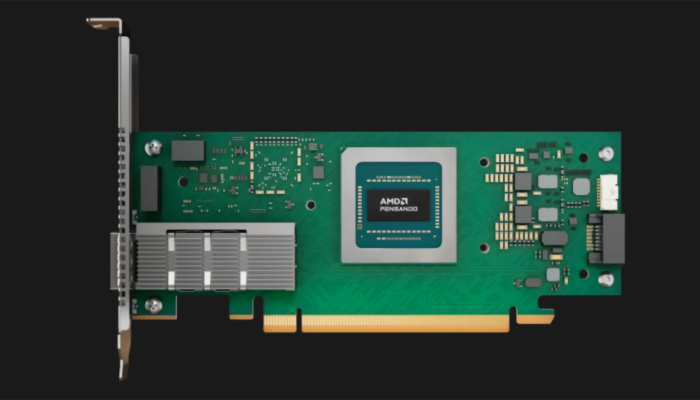
*Image from the internet; all rights belong to the original author, for reference only.
How Will AMD’s Launch of the World’s First Ultra Ethernet-Compatible Network Card Impact the Electronics Industry Supply Chain?
In 2024, with the explosive growth of demand for artificial intelligence (AI) and high-performance computing (HPC), data centers and enterprises face unprecedented challenges in network performance. Traditional Ethernet technology has become inadequate for handling large-scale AI cluster communications, prompting the need for next-generation solutions that can boost data transfer speeds and network efficiency. Against this backdrop, AMD introduced the Pensando Pollara 400, the world’s first network interface card (NIC) to support Ultra Ethernet, in October. This product aims to revolutionize networking for AI and HPC workloads, and its introduction is expected to spark innovation while having a profound impact on the electronics industry’s supply chain and related product fields
1. What are the key highlights of this product?
AMD’s launch of the Pensando Pollara 400, the world’s first network interface card (NIC) to support Ultra Ethernet, has captured significant attention. Specifically designed for Artificial Intelligence (AI) and High-Performance Computing (HPC), the card boasts an impressive 400 Gbps transmission speed along with intelligent multipath data transmission and congestion control features. These innovations allow the Pollara 400 to dynamically allocate data, preventing congestion and ensuring highly efficient, low-latency communication within large AI clusters. Its ability to optimize GPU-to-GPU communication makes it highly suitable for AI training and inference tasks, positioning it as a foundational component for reliable, scalable AI and HPC infrastructure.
2. How will this network card affect the electronics industry’s supply chain?
From a supply chain perspective, the Pollara 400 will significantly impact the demand for high-end components. AI and HPC systems require increasingly powerful processors, high-speed memory, and complex networking elements, which will drive up the demand for these advanced components. This presents new challenges for the upstream electronics supply chain, which will need to accelerate production to keep up with growing demand. The specialized nature of the Pollara 400 also indicates that the supply chain will need to incorporate more specialized hardware, pushing traditional network equipment manufacturers toward higher-performance, more specialized products. For companies like Cisco and Arista Networks, this shift may force them to adjust their supply chains and upgrade products to meet future Ultra Ethernet standards and high-performance AI requirements.
3. What impact will this product have on other product sectors?
The release of the Pollara 400 will not only impact network hardware but will also ripple through several other product sectors, particularly AI accelerators and traditional networking devices. For example, Nvidia’s BlueField DPU and A100 GPU, which dominate AI accelerator markets, will face direct competition. The Pollara 400’s 400 Gbps speed and advanced network control make it a powerful option for AI data centers, compelling Nvidia and other competitors to re-evaluate the performance and strategy behind their high-end products.
Traditional Ethernet equipment will also face significant pressure. The rise of Ultra Ethernet means that companies like Cisco will need to transition more quickly to high-performance network technology to keep up with the demands of AI and HPC applications. Moreover, storage and data transfer solutions will be affected. As network transmission speeds increase, enterprise storage systems will need to support higher data throughput, prompting vendors such as Dell EMC and HPE to upgrade their storage architectures to accommodate the demands of AI and HPC environments.
4. How will this product impact cloud computing platforms?
For cloud platforms, the AMD Pensando Pollara 400 could be a game-changer. Large cloud service providers such as AWS, Microsoft Azure, and Google Cloud may need to significantly upgrade their AI infrastructure to support this high-performance network solution. These platforms are already offering AI and HPC services, and with the introduction of a NIC that offers greater bandwidth and lower latency, they will be able to further enhance the quality of their services. As a result, Ultra Ethernet-supported cloud computing infrastructure could become a key differentiator, helping platforms to attract enterprise customers with high AI computing needs.
The introduction of AMD’s Pensando Pollara 400 represents a major technological breakthrough in AI and HPC networking, but its impact will extend far beyond that. As demand for high-performance networking increases, the entire electronics supply chain will need to shift toward more specialized components and hardware. This technological wave will also push product upgrades in AI accelerators, storage solutions, and cloud computing platforms. The industry players who can adapt and embrace these changes will be the ones who succeed in the AI era.
© 2024 Win Source Electronics. All rights reserved. This content is protected by copyright and may not be reproduced, distributed, transmitted, cached or otherwise used, except with the prior written permission of Win Source Electronics.

COMMENTS